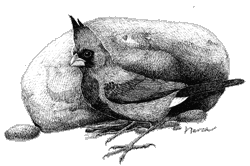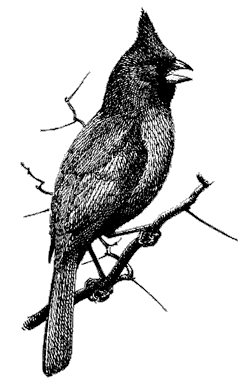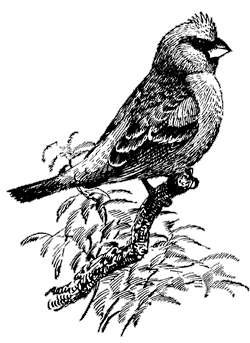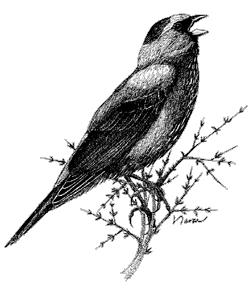Cardinals & Grosbeaks
The Northern Cardinal is among the most popular garden birds in eastern North America, chosen as the official state bird of seven eastern states. Travelers are often surprised to discover that, in the very different surroundings of the Sonoran Desert, the same cardinal is abundant—along with several other related birds.
 |
All the members of this group have thick bills, good for crushing hard seeds, which make up a high percentage of their diet at some seasons; most of them switch over to eating mainly insects during the nesting season. In all of our species, the males have bright colors and rich whistled songs. When they are not singing, they often hide their colors amidst dense foliage.
Very closely related to the cardinal is the Pyrrhuloxia. The male Pyrrhuloxia is mostly gray, with its red reduced to accents and highlights, but otherwise it and the cardinal are remarkably similar; some of their whistled songs are essentially identical. The two species live side by side in dense brush along desert washes, but the Pyrrhuloxia also ranges out into more open and arid places.
At the other end of the spectrum from these red birds are the Varied Bunting (mostly dark purple) and the Blue Grosbeak, mainly summer residents in the Sonoran Desert. Another species, the Black-headed Grosbeak, is mostly a denizen of oak woods in summer, but migrants show up all over the desert in spring and fall.
—Kenn KaufmanCardinals and Grosbeaks
Representative Sonoran Desert species
Northern Cardinal (Cardinalis cardinalis)
Pyrrhuloxia (Cardinalis sinuatus)
Blue Grosbeak (Guiraca caerulea)
Black-headed Grosbeak (Pheucticus melanocephalus)
Varied Bunting (Passerina versicolor)
Order: Passeriformes
Family: Cardinalidae
Spanish names: cardenal comun, chivo (Northern Cardinal), cardenal pardo,
cardenal torito (Pyrrhuloxia)
Distinguishing Features
 |
Northern Cardinal: The male is red with a reddish bill and black face. The young males have black bills. The female is light brown or tan and red with a red bill and crest. The female is commonly mistaken for a male Pyrrhuloxia, but the Cardinal female has a red bill as opposed to the ivory bill of the Pyrrhuloxia, and the Pyrrhuloxia is grayer.
Pyrrhuloxia: About 7¼ inches (19 cm) in length, the male is a slender grayish-tan and red bird with a crest and a small stubby, almost parrot-like bill. The rose-colored breast and crest suggest the female Cardinal, but the gray back and ivory-colored bill set it apart. The female has a gray back, buff breast, a touch of red in the wings and crest and an ivory-colored bill.
Blue Grosbeak: This bird measures 6 to 7¼ inches (15 to 19 cm). The adult male is dark blue with 2 rust-colored wing bars. The female is dull brown with buff wing bars. As with other grosbeaks, this species has a heavy, conical bill.
Black-headed Grosbeak: This grosbeak measures 6¼ to 7¼ inches (17 to 19 cm). The adult male has a black head, brownish-orange underparts, and black wings with white wing bars. The female has a striped head, streaked back and sides, and sparsely streaked buff-colored breast. The heavy, conical bill is pale in both sexes.
Varied Bunting: This attractive bunting measures 4¼ to 5¼ inches (11 to 14 cm). The adult male has a plum or red-purple body, a blue crown, and a bright red patch on the back of the head. In poor light the bird looks black. Females and immatures are unstreaked gray-brown above and buffy below.
Habitat
The Northern Cardinal covers a large range, from southern Ontario to the Gulf states, and from the southwestern United States to Belize and Guatemala. In Mexico, it is a resident of central and southern Baja California. It is widespread from the northern states to the Isthmus of Tehuantepec and east through the Yucatan peninsula. It prefers wood-land edges, mesquite thickets and stream edges.
Pyrrhuloxias occur from the borders of Arizona, New Mexico, and Texas southward to central Mexico and central and southern Baja California. They frequent mesquite, thorn scrub and deserts.
 |
The Blue Grosbeak is found generally in the southern half of the United States south to Central America. It winters from northern Mexico to Panama. This bird inhabits brush, streamside vegetation, roadsides, and overgrown fields. In the southwest U.S., this species is most often found near water in streamside thickets or mesquite bosques.
The Black-headed Grosbeak is found from southern British Columbia and Saskat-chewan, through the western half of the United States, south to its wintering grounds in western Mexico. This bird inhabits foothills and dense riverside wooded areas. It breeds mainly in deciduous and mixed woods such as cottonwood and willow groves, pine-oak and pinyon-juniper woodlands. In migration its habitat includes open woods, riparian areas, mesquite bosques, desert washes, and even suburban areas.
The Varied Bunting is found from the extreme southern parts of Arizona and New Mexico and southwestern Texas south into Mexico. Most of these birds migrate a short distance into Mexico during winter. This bird inhabits dense and thorny habitat, streamside thickets, and open desert if there is dense brush available.
Feeding
• Diet: All species feed on insects, berries, and seeds; Blue Grosbeak adds spiders, snails, and plant parts to its diet; Black-headed Grosbeak includes spiders and snails. It is able to feed on Monarch butterflies in spite of the noxious chemicals they exude.
• Behavior: The Blue Grosbeak forages on the ground and from plants; it also flies out to catch insects midair or hovers and removes them from foliage. This species commonly forages in flocks during winter and migration, but not in the breeding season.
Black-headed Grosbeak forages by hovering and taking prey from the foliage of shrubs and trees and by flying out to catch insects midair.
The diet of the Varied Bunting is not well known, but probably consists of seeds, insects, and some berries. Insects are probably taken from leaves, and seeds from the ground. This species forages in flocks during winter.
Life History
Northern Cardinal: Nesting begins from late March to early April. The cup-shaped nest of twigs and plant stems is lined with grasses and hairs. It is located 5 to 10 feet (1.5-3 m) high in dense shrubbery or mesquites. There are usually 3 to 4 eggs that are incubated for 12 to 13 days. The altricial young leave the nest at about 10 days. Cardinals typically raise 2 to 3 broods per year.
Pyrrhuloxias begin nesting from mid March to early April. The nest is a compact cup of twigs lined with grasses and hair, located 5 to 8 feet (1.5-2.5 m) above ground in a forked branch or against the main trunk of a mesquite or other tree. The 2 to 5 eggs are incubated for 14 days and the altricial young leave the nest at 10 days.
Blue Grosbeak: The open cup-shaped nest is usually rather low in shrubs and trees. It is made of twigs, weeds, leaves, bark, and rootlets with a lining made of finer material such as fine grass and animal hair. Other items, such as pieces of fabric, string, or paper are also often incorporated into the nest. There are 3 to 5 pale blue eggs that take about 12 days to hatch. The nestlings, which are fed entirely by the female, leave the nest about 10 to 12 days after hatching. The male may begin to feed the young after they fledge, thus allowing the female to begin a second brood.
 |
Black-headed Grosbeak: This male’s courtship display involves flying above the female with wings and tail spread open and singing. The bulky, open cup-shaped nest is built by the female in trees or large shrubs. It is made of twigs, weeds, pine needles, and rootlets with a lining made of finer material such as fine grass and animal hair. Two to 5 pale greenish blue eggs with reddish brown spots are incubated by both parents. The young take about 12 to 14 days to hatch. The nestlings are able to fly about a month after hatching but remain nearby to be fed by their parents.
Varied Bunting: The nest, which is built by both parents, is a compact open cup made of grass, weeds, and plant stems lined with finer material. It is typically located in the crotches of dense shrubs or trees. Bluish-white eggs (3 to 5) are incubated by the female in 12 to 13 days. The young leave the nest after 12 days. Shortly after fledging occurs the male may take on the responsibility of feeding half the brood thus allowing the female to attempt another nesting. In Arizona the varied bunting’s nesting is timed to summer rains.










